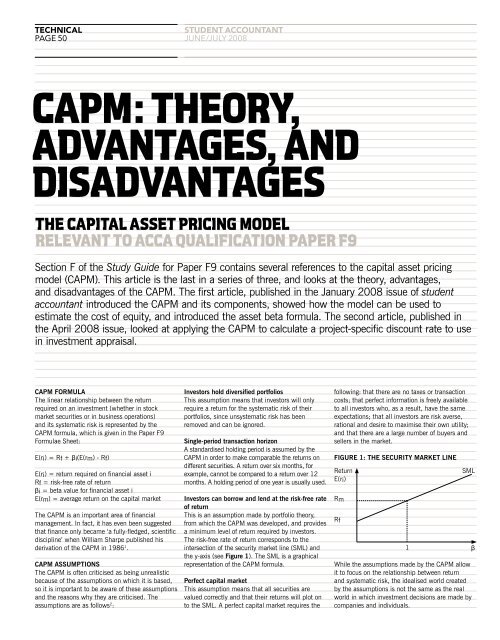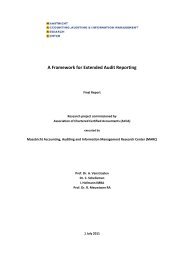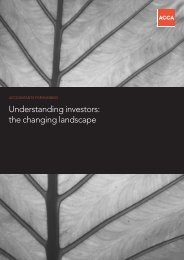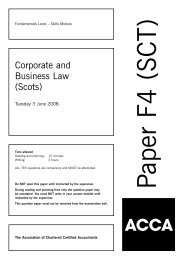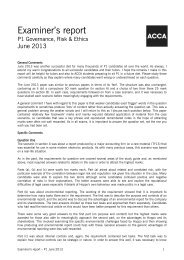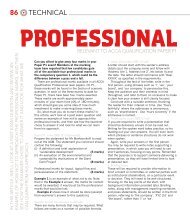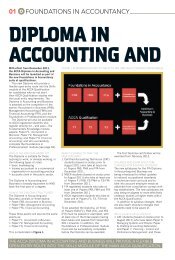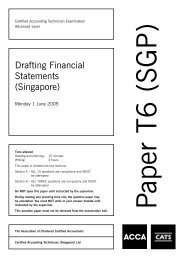CAPM: THEORY, ADVANTAGES, AND DISADVANTAGES - ACCA
CAPM: THEORY, ADVANTAGES, AND DISADVANTAGES - ACCA
CAPM: THEORY, ADVANTAGES, AND DISADVANTAGES - ACCA
You also want an ePaper? Increase the reach of your titles
YUMPU automatically turns print PDFs into web optimized ePapers that Google loves.
technical<br />
page 50<br />
student accountant<br />
JUNe/JULY 2008<br />
<strong>CAPM</strong>: <strong>THEORY</strong>,<br />
<strong>ADVANTAGES</strong>, <strong>AND</strong><br />
DIS<strong>ADVANTAGES</strong><br />
THE CAPITAL ASSET PRICING MODEL<br />
RELEVANT TO <strong>ACCA</strong> QUALIFICATION PAPER F9<br />
Section F of the Study Guide for Paper F9 contains several references to the capital asset pricing<br />
model (<strong>CAPM</strong>). This article is the last in a series of three, and looks at the theory, advantages,<br />
and disadvantages of the <strong>CAPM</strong>. The first article, published in the January 2008 issue of student<br />
accountant introduced the <strong>CAPM</strong> and its components, showed how the model can be used to<br />
estimate the cost of equity, and introduced the asset beta formula. The second article, published in<br />
the April 2008 issue, looked at applying the <strong>CAPM</strong> to calculate a project-specific discount rate to use<br />
in investment appraisal.<br />
<strong>CAPM</strong> FORMULA<br />
The linear relationship between the return<br />
required on an investment (whether in stock<br />
market securities or in business operations)<br />
and its systematic risk is represented by the<br />
<strong>CAPM</strong> formula, which is given in the Paper F9<br />
Formulae Sheet:<br />
E(ri) = Rf + βi(E(rm) - Rf)<br />
E(ri) = return required on financial asset i<br />
Rf = risk-free rate of return<br />
βi = beta value for financial asset i<br />
E(rm) = average return on the capital market<br />
The <strong>CAPM</strong> is an important area of financial<br />
management. In fact, it has even been suggested<br />
that finance only became ‘a fully-fledged, scientific<br />
discipline’ when William Sharpe published his<br />
derivation of the <strong>CAPM</strong> in 1986 1 .<br />
<strong>CAPM</strong> ASSUMPTIONS<br />
The <strong>CAPM</strong> is often criticised as being unrealistic<br />
because of the assumptions on which it is based,<br />
so it is important to be aware of these assumptions<br />
and the reasons why they are criticised. The<br />
assumptions are as follows 2 :<br />
Investors hold diversified portfolios<br />
This assumption means that investors will only<br />
require a return for the systematic risk of their<br />
portfolios, since unsystematic risk has been<br />
removed and can be ignored.<br />
Single-period transaction horizon<br />
A standardised holding period is assumed by the<br />
<strong>CAPM</strong> in order to make comparable the returns on<br />
different securities. A return over six months, for<br />
example, cannot be compared to a return over 12<br />
months. A holding period of one year is usually used.<br />
Investors can borrow and lend at the risk-free rate<br />
of return<br />
This is an assumption made by portfolio theory,<br />
from which the <strong>CAPM</strong> was developed, and provides<br />
a minimum level of return required by investors.<br />
The risk-free rate of return corresponds to the<br />
intersection of the security market line (SML) and<br />
the y-axis (see Figure 1). The SML is a graphical<br />
representation of the <strong>CAPM</strong> formula.<br />
Perfect capital market<br />
This assumption means that all securities are<br />
valued correctly and that their returns will plot on<br />
to the SML. A perfect capital market requires the<br />
following: that there are no taxes or transaction<br />
costs; that perfect information is freely available<br />
to all investors who, as a result, have the same<br />
expectations; that all investors are risk averse,<br />
rational and desire to maximise their own utility;<br />
and that there are a large number of buyers and<br />
sellers in the market.<br />
FIGURE 1: THE SECURITY MARKET LINE<br />
Return<br />
E(ri)<br />
Rm<br />
Rf<br />
SML<br />
1 β<br />
While the assumptions made by the <strong>CAPM</strong> allow<br />
it to focus on the relationship between return<br />
and systematic risk, the idealised world created<br />
by the assumptions is not the same as the real<br />
world in which investment decisions are made by<br />
companies and individuals.
technical<br />
page 51<br />
For example, real-world capital markets are<br />
clearly not perfect. Even though it can be argued<br />
that well-developed stock markets do, in practice,<br />
exhibit a high degree of efficiency, there is scope<br />
for stock market securities to be priced incorrectly<br />
and, as a result, for their returns not to plot on to<br />
the SML.<br />
The assumption of a single-period transaction<br />
horizon appears reasonable from a real-world<br />
perspective, because even though many investors<br />
hold securities for much longer than one year,<br />
returns on securities are usually quoted on an<br />
annual basis.<br />
The assumption that investors hold diversified<br />
portfolios means that all investors want to hold a<br />
portfolio that reflects the stock market as a whole.<br />
Although it is not possible to own the market<br />
portfolio itself, it is quite easy and inexpensive<br />
for investors to diversify away specific or<br />
unsystematic risk and to construct portfolios that<br />
‘track’ the stock market. Assuming that investors<br />
are concerned only with receiving financial<br />
compensation for systematic risk seems therefore<br />
to be quite reasonable.<br />
A more serious problem is that, in reality,<br />
it is not possible for investors to borrow at the<br />
risk-free rate (for which the yield on short-dated<br />
Government debt is taken as a proxy). The reason<br />
for this is that the risk associated with individual<br />
investors is much higher than that associated with<br />
the Government. This inability to borrow at the<br />
risk-free rate means that the slope of the SML is<br />
shallower in practice than in theory.<br />
Overall, it seems reasonable to conclude that<br />
while the assumptions of the <strong>CAPM</strong> represent<br />
an idealised rather than real-world view, there<br />
is a strong possibility, in reality, of a linear<br />
relationship existing between required return and<br />
systematic risk.<br />
WACC <strong>AND</strong> <strong>CAPM</strong><br />
The weighted average cost of capital (WACC)<br />
can be used as the discount rate in investment<br />
appraisal provided that a number of restrictive<br />
assumptions are met. These assumptions<br />
are that:<br />
the investment project is small compared to<br />
the investing organisation<br />
the business activities of the investment<br />
project are similar to the business activities<br />
currently undertaken by the investing<br />
organisation<br />
the financing mix used to undertake the<br />
investment project is similar to the current<br />
financing mix (or capital structure) of the<br />
investing company<br />
existing finance providers of the investing<br />
company do not change their required rates<br />
of return as a result of the investment project<br />
being undertaken.<br />
These assumptions essentially state that WACC<br />
can be used as the discount rate provided that<br />
linked performance objectives<br />
performaNce obJectives 15 aNd 16 are reLevaNt to paper f9<br />
the investment project does not change either<br />
the business risk or the financial risk of the<br />
investing organisation.<br />
If the business risk of the investment project is<br />
different to that of the investing organisation, the<br />
<strong>CAPM</strong> can be used to calculate a project-specific<br />
discount rate. The procedure for this calculation<br />
was covered in the second article in this series 3 .<br />
The benefit of using a <strong>CAPM</strong>-derived<br />
project-specific discount rate is illustrated in<br />
Figure 2. Using the <strong>CAPM</strong> will lead to better<br />
investment decisions than using the WACC in the<br />
two shaded areas, which can be represented by<br />
projects A and B.<br />
Project A would be rejected if WACC was used<br />
as the discount rate, because the internal rate<br />
of return (IRR) of the project is less than that of<br />
the WACC. This investment decision is incorrect,<br />
however, since project A would be accepted if<br />
a <strong>CAPM</strong>-derived project-specific discount rate<br />
were used because the project IRR lies above the<br />
SML. The project offers a return greater than that<br />
needed to compensate for its level of systematic<br />
risk, and accepting it will increase the wealth<br />
of shareholders.<br />
Project B would be accepted if WACC was<br />
used as the discount rate because its IRR is<br />
greater than the WACC.<br />
This investment decision is also incorrect,<br />
however, since project B would be rejected if<br />
using a <strong>CAPM</strong>-derived project-specific discount<br />
rate, because the project IRR offers insufficient<br />
compensation for its level of systematic risk 4 .<br />
FIGURE 2: WACC OR <strong>CAPM</strong>?<br />
Required rate of return %<br />
C<br />
Rf<br />
0<br />
A<br />
x<br />
Company β<br />
SML<br />
B<br />
x<br />
WACC<br />
<strong>ADVANTAGES</strong> OF THE <strong>CAPM</strong><br />
The <strong>CAPM</strong> has several advantages over other<br />
methods of calculating required return, explaining<br />
why it has remained popular for more than 40 years:<br />
It considers only systematic risk, reflecting a<br />
reality in which most investors have diversified<br />
portfolios from which unsystematic risk has<br />
been essentially eliminated.<br />
D<br />
β
technical<br />
page 52<br />
It generates a theoretically-derived relationship<br />
between required return and systematic risk<br />
which has been subject to frequent empirical<br />
research and testing.<br />
It is generally seen as a much better method of<br />
calculating the cost of equity than the dividend<br />
growth model (DGM) in that it explicitly takes<br />
into account a company’s level of systematic<br />
risk relative to the stock market as a whole.<br />
It is clearly superior to the WACC in providing<br />
discount rates for use in investment appraisal.<br />
DIS<strong>ADVANTAGES</strong> OF THE <strong>CAPM</strong><br />
The <strong>CAPM</strong> suffers from a number of disadvantages<br />
and limitations that should be noted in a balanced<br />
discussion of this important theoretical model.<br />
Assigning values to <strong>CAPM</strong> variables<br />
In order to use the <strong>CAPM</strong>, values need to be<br />
assigned to the risk-free rate of return, the return<br />
on the market, or the equity risk premium (ERP),<br />
and the equity beta.<br />
The yield on short-term Government debt,<br />
which is used as a substitute for the risk-free rate<br />
of return, is not fixed but changes on a daily basis<br />
according to economic circumstances. A short-term<br />
average value can be used in order to smooth out<br />
this volatility.<br />
Finding a value for the ERP is more difficult.<br />
The return on a stock market is the sum of the<br />
average capital gain and the average dividend yield.<br />
In the short term, a stock market can provide a<br />
negative rather than a positive return if the effect of<br />
student accountant<br />
JUNe/JULY 2008<br />
falling share prices outweighs the dividend yield. It<br />
is therefore usual to use a long-term average value<br />
for the ERP, taken from empirical research, but it<br />
has been found that the ERP is not stable over time.<br />
In the UK, an ERP value of between 2% and 5% is<br />
currently seen as reasonable. However, uncertainty<br />
about the exact ERP value introduces uncertainty<br />
into the calculated value for the required return.<br />
Beta values are now calculated and published<br />
regularly for all stock exchange-listed companies.<br />
The problem here is that uncertainty arises in the<br />
value of the expected return because the value of<br />
beta is not constant, but changes over time.<br />
Using the <strong>CAPM</strong> in investment appraisal<br />
Problems can arise when using the <strong>CAPM</strong> to<br />
calculate a project-specific discount rate. For<br />
example, one common difficulty is finding suitable<br />
proxy betas, since proxy companies very rarely<br />
undertake only one business activity. The proxy<br />
beta for a proposed investment project must be<br />
disentangled from the company’s equity beta. One<br />
way to do this is to treat the equity beta as an<br />
average of the betas of several different areas of<br />
proxy company activity, weighted by the relative<br />
share of the proxy company market value arising<br />
from each activity. However, information about<br />
relative shares of proxy company market value may<br />
be quite difficult to obtain.<br />
A similar difficulty is that the ungearing<br />
of proxy company betas uses capital structure<br />
information that may not be readily available.<br />
Some companies have complex capital structures<br />
with many different sources of finance. Other<br />
companies may have debt that is not traded, or<br />
use complex sources of finance such as convertible<br />
bonds. The simplifying assumption that the<br />
beta of debt is zero will also lead to inaccuracy<br />
in the calculated value of the project-specific<br />
discount rate.<br />
One disadvantage in using the <strong>CAPM</strong> in<br />
investment appraisal is that the assumption of<br />
a single-period time horizon is at odds with the<br />
multi-period nature of investment appraisal. While<br />
<strong>CAPM</strong> variables can be assumed constant in<br />
successive future periods, experience indicates that<br />
this is not true in reality.<br />
CONCLUSION<br />
Research has shown the <strong>CAPM</strong> to stand up well<br />
to criticism, although attacks against it have been<br />
increasing in recent years. Until something better<br />
presents itself, however, the <strong>CAPM</strong> remains a very<br />
useful item in the financial management toolkit.<br />
REFERENCES<br />
1 Megginson W L, Corporate Finance Theory,<br />
Addison-Wesley, p10, 1996.<br />
2 Watson D and Head A, 2007, Corporate<br />
Finance: Principles and Practice, 4th edition,<br />
FT Prentice Hall, pp222–3.<br />
3 Project-specific discount rates, student<br />
accountant, April 2008.<br />
4 Watson and Head, pp252–3.<br />
Tony Head is examiner for Paper F9


